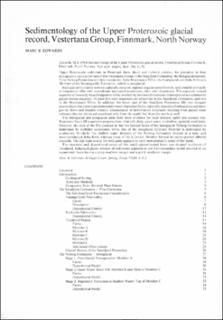| dc.description.abstract | Upper Proterozoic sediments in Finnmark show direct and indirect evidence for glaciation in four stratigraphic units at the base of the Vestertana Group: 1) the Smalfjord Formation, the first glacial episode. 2) the Nyborg Formation which is interglacial. 3) the Mortensnes Tillite, the final glacial. and 4) the Lillevatn Member of the Stappogiedde Formation, which is postglacial. Each glacial formation rests on a glacially scoured, regional angular unconfirmity, and consists primarily of lodgement tillite with subordinate laminated mudstones, often with dropstones. The repeated vertical sequence of erosively-based lodgement tillite overlain by laminated mudstone interpreted as a submarine glacial retreat sequence of erosively-based lodgement tillite overlain by laminated mudstone is interpreted as a submarine glacial retreat sequence. At least five such sequences are preserved in the Smalfjord Formation, and two in the Mortensnes Tillite. In addition, the lower part of the Smalfjord Formation fills two elongate paleovalleys that contain predominantly water-deposited facies, especially deposits of subaqueous sediment gravity flows and braided streams. Examination of deformation structures resulting from glacial shear indicates that ice sheets advanced not only from the south, but from the north as well. The interglacial and postglacial units both show evidence for local isostatic uplift and eustatic rise. Regressive basin fill sequences progress from relatively deep, quiet water, to shallow, agitated conditions. However, the style of the fills contrast in that the basinal facies of the interglacial Nyborg Formation is dominated by turbidite sandstones, while that of the postglacial Lillevatn Member is dominated by mudstones. Similarly, the shallow water deposits of the Nyborg Formation formed in a tide- and wave-dominated delta front, whereas those of the Lilleva | |

